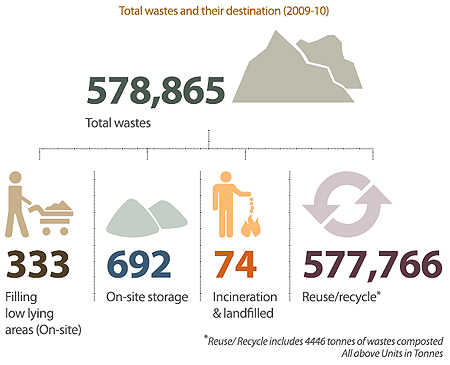Waste Destination
The chart below depicts the final destinations of total wastes –
 The percentage of waste recycled increased from 98.8% to 99.8% in 2009-10. Bhadrachalam, the largest integrated Paper & Paperboards and Specialty Papers mill in India, generated 75% of ITC’s total wastes and recycled more than 99% in 2009-10 – a noteworthy achievement. Bhadrachalam generated 1030 kg of waste per tonne of paper/paperboard in 2009-10; an increase of 5.9% over last year (973 kg/tonne in 2008-09), due to increased pulp production as a substitute for imported pulp and the change in the product mix over the previous year. However, this is better than the performance of all other integrated mills in India. According to the Centre for Science and Environment’s Report “All About Paper”, (2004), similar mills generated 1200 Kg. of solid waste per tonne of paper. The percentage of waste recycled increased from 98.8% to 99.8% in 2009-10. Bhadrachalam, the largest integrated Paper & Paperboards and Specialty Papers mill in India, generated 75% of ITC’s total wastes and recycled more than 99% in 2009-10 – a noteworthy achievement. Bhadrachalam generated 1030 kg of waste per tonne of paper/paperboard in 2009-10; an increase of 5.9% over last year (973 kg/tonne in 2008-09), due to increased pulp production as a substitute for imported pulp and the change in the product mix over the previous year. However, this is better than the performance of all other integrated mills in India. According to the Centre for Science and Environment’s Report “All About Paper”, (2004), similar mills generated 1200 Kg. of solid waste per tonne of paper.
In 2009-10, ITC generated 245,820 tonnes of fly ash, (42.5% of total waste in ITC), which is 36.9% more than the previous year due to low-grade coal and significant growth in production volumes in the Paperboards and Specialty Papers business. Despite this increase, we have ensured 100% fly ash utilisation for brick making, road/embankment construction and as a raw material in cement factories. |

